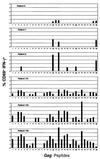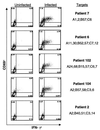HLA B*5701 is highly associated with restriction of virus replication in a subgroup of HIV-infected long term nonprogressors
- PMID: 10694578
- PMCID: PMC15994
- DOI: 10.1073/pnas.050567397
HLA B*5701 is highly associated with restriction of virus replication in a subgroup of HIV-infected long term nonprogressors
Abstract
A unique cohort of HIV-1-infected long term nonprogressors (LTNP) with normal CD4(+) T cell counts and <50 copies/ml of plasma were prospectively recruited for study. HLA typing revealed a dramatic association between the HLA B*5701 class I allele and nonprogressive infection [85% (11 of 13) vs. 9.5% (19 of 200) in progressors; P < 0. 001]. Antigen-specific CD8(+) T cells were enumerated by flow cytometric detection of intracellular IFN-gamma in response to HIV antigens and HLA B*57-gag tetramer staining. No quantitative differences in the total HIV-specific CD8(+) T cell responses were observed between B*57(+) LTNP and five B*57(+) progressors (P = 0.4). Although similar frequencies of peptide specific CD8(+) T cells were also found, the gag-specific CD8(+) T cell response in the LTNP group was highly focused on peptides previously shown to be B*57-restricted. These findings indicate that, within this phenotypically and genotypically distinct cohort, a host immune factor is highly associated with restriction of virus replication and nonprogressive disease. They also strongly suggest a mechanism of virus specific immunity that directly operates through the B*5701 molecule. Further characterization of qualitative differences in the virus-specific responses that distinguish HLA B*57(+) LTNP from progressors may ultimately define mechanisms of effective immune mediated restriction of virus replication.
Figures



References
-
- Barker E, Mackewicz C E, Reyes-Teran G, Sato A, Stranford S A, Fujimura S H, Christopherson C, Chang S Y, Levy J A. Blood. 1998;92:3105–3114. - PubMed
-
- Pantaleo G, Menzo S, Vaccarezza M, Graziosi C, Cohen O J, Demarest J F, Montefiori D, Orenstein J M, Fox C, Schrager L J, et al. N Engl J Med. 1995;332:209–216. - PubMed
-
- Cao Y, Qin L, Zhang L, Safrit J, Ho D D. N Engl J Med. 1995;332:201–208. - PubMed
-
- Pilgrim A K, Pantaleo G, Cohen O J, Fink L M, Zhou J Y, Zhou J T, Bolognesi D P, Fauci A S, Montefiori D C. J Infect Dis. 1997;176:924–932. - PubMed
MeSH terms
Substances
LinkOut - more resources
Full Text Sources
Other Literature Sources
Research Materials

